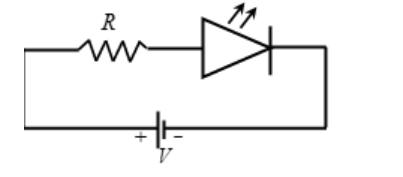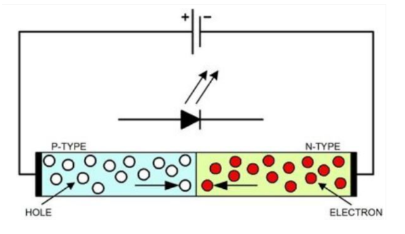Table of Contents
Light emitting diodes are widely used as a source of light in digital displays, advertising boards, time display boards, short announcements display boards, arrivals/departure information in railway/airports, remote controls, etc.
Many of their properties make them get preference over incandescent lamps.
Light emitting diode

It is a semiconductor-based p-n junction diode, having small area, roughly , that emits light when it is forward biased. When it is forward biased, the electrons present in conduction band recombine with holes present in the valence band at the junction of the diode. Electrons fall from higher energy state to lower energy state. Thus energy is released during recombination of electrons with holes. This energy is normally in the form of light – generally in visible, ultraviolet, or infrared region of spectrum.
Symbol of LED
The symbol of LED is shown. It is similar to that of a normal p-n junction diode, except with the addition of two arrows to represent emission of light.

How is LED connected in a circuit?

A simple circuit involving LED is shown. An LED is connected in a circuit in such a way that it is in forward biased and current through it does not exceed the rated value. This is done by using a resistance of suitable value. The role of resistor is crucial to limit the current flow into the LED.
Working principle of an LED

LED works on the principle of electroluminescence, wherein a material emits light when a current is passed through it. When the diode is forward biased, free electrons in the conduction band of n side are pushed towards the junction, as well as holes of p side in valence band are pushed towards the junction.
Conduction band electrons have more energy than those in valence band. At the junction boundary, conduction band electrons descend to recombine with holes. This leads to lowering of their energy. Thus recombination leads to emission of energy. Energy released is in the form of heat in standard diodes. In LEDs, energy released lies in visible region of electromagnetic spectrum. As the forward voltage is increased, the intensity of the light increases and reaches a maximum.
Colour variation in LEDs
Materials used in the fabrication of LEDs decide which colour of light they would emit.
Aluminium gallium indium phosphide alloys and indium gallium nitride alloys are generally used. Using alloys of aluminium red, orange and yellow LEDs are fabricated, whereas using Indium alloys, green, blue and white LEDs are made. Colour of light can be varied by making suitable changes in proportion of the alloys.
- Gallium Arsenide diodes emit infrared light.
- Gallium Arsenide phosphide LEDs emit red to infrared, orange light.
- There are also multicolour LEDs – they produce one colour when connected in forward bias and a different colour when connected in reverse bias.
LEDs versus normal p-n junction diodes
- LED consume more power than silicon or Germanium based diodes.
- The voltage drop across LED in operation can vary between 2V to 3V compared with 0.7 V for Si and 0.3 V for Ge based diodes.
- LEDs have much lower reverse breakdown voltage than Si or Ge based diodes.
- General purpose diodes find use as voltage rectification, clipping and clamping circuits, voltage multipliers. LEDs have use to display letters, date-time, control switches, in camera flashes.
Why are LEDs preferred?
- Low power consumption
- They last longer and exhibit ruggedness
- Low operational voltages
- No warm-up time
- Light of very small band of frequencies can be emitted
- Environment-friendly
- Doesn’t get affected by cold temperatures
FAQs on LED (Light emitting diode)
What is an LED?
LED is a semi-conductor based device that emits light when it is suitably forward biased and current is passed through it.
What are the uses of LEDs?
They have wide range of applications. They are used as a source of light in digital displays, advertising boards, date-time display boards, short announcement display boards, arrivals/departure information in railway/airports etc. They are used as torch lights in mobile phones, used in TV remote controls.
What is the principle of working of LEDs?
LED works on the principle of electroluminescence. When a current is passed through a materia, it starts emitting light. In LED, recombination of charge carriers takes place at the junction when the diode is forward biased. Recombination causes release of energy in the form of light.
What are the advantages of LEDs?
Low operational voltage, low power consumption, ruggedness, long life, no warm-up time, Frequency band is very small.
Is light from an LED coherent like laser light?
No. LED light is not by stimulated emission of radiation. Laser light is coherent because it is generated by stimulated emission of radiation.









